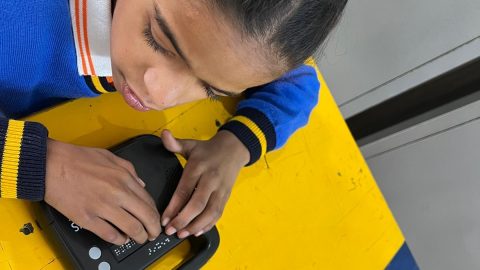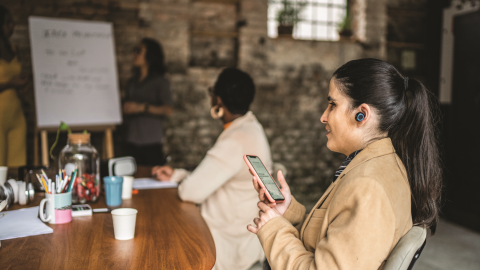Accessible Events, Climbing Toddlers and Barking Dogs
Each year, springtime brings raindrops to Seattle, flowers blooming in my garden, and events popping up across the accessibility community. In my role leading Strategic Partnerships for Accessibility at Microsoft, I look forward to seeing old friends and shaking hands with new inclusion champions at events. COVID-19 has disrupted those in-person events and moved our interactions to the virtual world. But, with every disruption comes the opportunity for innovation!
Over the last few months, many of you have reached out to ask how can event professionals create inclusive digital experiences that are accessible to all attendees?
Learning from attendees with disabilities is the key to unlocking inclusive events! I am learning more every day and don’t have all the answers, but I do know that people with disabilities are first adopters and innovators. In the physical world, disabled attendees have taught us about stepless entrances, Braille signage, platform sign language interpreters, and quiet rooms. Now as we leave our physical venues behind us, tap into insights from the disability community as you move into the digital world. There is a wealth of advice on virtual events already out there, especially from our Microsoft Teams group. Below are some tips for creating accessible virtual events I have picked up along the way:
1. Accessibility is paramount!
- Platform. Accessibility must be part of the event design from day 1, not a bolt on afterthought. Ask your platform supplier about accessibility. Ensure that people with disabilities have tested the platform for accessibility. The lived experience matters. If your platform is web-based, try Accessibility Insights to detect common accessibility errors and make recommendations for fixes. To get support hosting live events in Microsoft Teams, Stream and Yammer, check out aka.ms/liveevents.
- Captions. Attendees who are deaf and hard of hearing have taught us that captions are truly inclusive design! With playful kiddos or barking dogs in the work-from-home office, captions allow many attendees to follow along amidst distraction. We use CART services for many of our events, but also try live captions and subtitles within PowerPoint and Stream.
- Sign Language Interpreters. We continue to thank the Deaf community for raising awareness of sign language interpretation during this difficult time, especially as more and more government press briefings include onscreen interpreters. Be sure to follow their lead by hiring interpreters well in advance of your event and follow best practices for remote interpretation in your livestreams and recordings.
- Audio. Find a calming place like a small room with soft walls, such as curtains, to practice and record. Be aware of distracting ambient noise, like a buzzing fan or ticking air conditioner that can be distracting for captioning and sign language interpretation.
- Visual. Provide inclusive presentation training in advance for your presenters. Ask them to practice meaningful descriptions of images that allow Blind and low vision attendees to understand photos, charts, graphs, and more. You should also add Audio Descriptions to videos during post-production. Presenters can practice public speaking with Presenter Coach in PowerPoint, get real time feedback on pacing and pitch, as well as reminders to use inclusive language.
- Materials in Advance. By posting materials in advance, all attendees will have a chance to explore your platform to become more comfortable living and breathing in the virtual world you create. Attendees who use screenreaders and other Assistive Technology should have ample time to review all the materials before you go live.
- Schedule Breaks. Just like in-person events, allow for breaks in between sessions. Your attendees will appreciate the time to duck into a quiet space to decompress, use technology to manage their mental health and wellbeing, tab through an unfamiliar new app, and refill coffee.
2. Content that meets the needs of your diverse virtual audience.
- Share Your Agenda. Digital participants want to know exactly how they will be spending their time, especially if returning later to consume content on demand. Begin your presentation with a brief summary of the topics and objectives of the session. If you are using a slide deck in your presentation, let PowerPoint Designer do the work by recommending beautifully formatted lists with just a click or two.
- Shorter is Better. Audience attention spans for online content are much shorter than in-person. No need for lengthy introductions here, it’s all about making each moment count. Microsoft Editor uses AI to make suggestions for more concise writing and word choice. You can also learn lot about plain language and crisp soundbites from colleagues with cognitive disabilities. Ask someone with a disability to collaborate on your draft and you’ll be delighted with the improvements to your writing style.
- Dress for Success. If you’re like me, you’ve been wearing yoga pants and hoodies for the last month or so. But for your event presentation, choose solid colors and avoid small prints or patterns that tend to vibrate on camera and strain eyes. Avoid noisy jewelry like necklaces and bracelets that may make it difficult for captioners and interpreters to understand the spoken word.
- Have Fun! We all deserve to smile, giggle, and laugh even during these uncertain times. Give your attendees more to smile about by adding a tropical background image or sharing a fun fact about disability history.
Today, I sit in my kitchen typing this blog with a toddler climbing my wheelchair and two dogs barking at the air. I realize that I still have a lot to learn about working remotely, balancing life and work, and of course planning events in this all-digital world. But, I also realize that accessibility awareness is too important to wait until we have all the answers. So, we are sharing what we know within our updated Accessible Events Guide and embedding our learnings into the all-virtual Ability Summit.
Please join people with disabilities, allies, and accessibility practitioners at the 2020 Ability Summit (May 27-28) to Imagine, Build, Include, and Empower the future of disability inclusion and accessibility. Register today at aka.ms/AbilitySummit. Until then, stay safe and be accessible!








